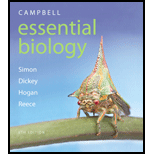
Which of the following structures is common to all four major plant groups? vascular tissue, flowers, seeds, cuticle, pollen
To determine:
Which of the given structures (vascular tissue, flowers, seeds, cuticle, and pollen) are common to all four major plant groups.
Introduction:
The four major modern plant groups are bryophytes (non-vascular plants, for example, mosses), pteridophytes (seedless vascular plants, for example, ferns), gymnosperms (naked-seed plants, for example, conifers), and angiosperms (flowering plants, for example, pea plant).
Explanation of Solution
A vascular tissue is a conducting tissue, which helps in transporting nutrients and fluids internally. Bryophytes lack vascular tissues, and pteridophytes cannot produce flowers and seeds. Among the four major plant groups, only angiosperms and gymnosperms produce pollen.
Among the given structures, only cuticle is common to all land plants belonging to the four groups of modern plants. The cuticle is a layer of protection on young shoots, leaves, and other aerial plant parts. The terrestrial plants are highly exposed to the sunlight and this may increase the transpiration process in plants. The cuticle is a waxy layer that coats the aerial parts (for example, leaves) of a majority of plants. It prevents the water transpiration and therefore helps the plant body to retain water. The transpiration process is controlled by the cuticle during high temperature.
Out of all five structures provided, only cuticle is present in all four plant groups, namely bryophytes, pteridophytes, gymnosperms, and angiosperms.
Want to see more full solutions like this?
Chapter 16 Solutions
Campbell Essential Biology (6th Edition) - standalone book
- How is a protein destined for the Endoplasmic Reticulum (ER), imported into the ER? Be concise.arrow_forwardFind out about the organisations and the movements aimed at the conservation of our natural resources. Eg Chipko movement and Greenpeace. Make a project report on such an organisation.arrow_forwardWhat are biofertilizers and mention the significancearrow_forward
- PCBs and River Otters: Otters in Washington State’s Green-Duwamish River have high levels of polychlorinated biphenyls (PCBs) in their livers. PCBs can bind to the estrogen receptors in animals and disrupt the endocrine system of these otters. The PCBs seem to increase the estrogen to androgen ratio, skewing the ratio toward too much estrogen. How would increased estrogen affect the river otter population? Based on your reading of the materials in this unit, what factors can affect fertility in humans? Explain how each of the factors affecting human fertility that you described can disrupt the human endocrine system to affect reproduction.arrow_forwardOther than oil and alcohol, are there other liquids you could compare to water (that are liquid at room temperature)? How is water unique compared to these other liquids? What follow-up experiment would you like to do, and how would you relate it to your life?arrow_forwardSelection of Traits What adaptations do scavengers have for locating and feeding on prey? What adaptations do predators have for capturing and consuming prey?arrow_forward
- Competition Between Species What natural processes limit populations from growing too large? What are some resources organisms can compete over in their natural habitat?arrow_forwardSpecies Interactions Explain how predators, prey and scavengers interact. Explain whether predators and scavengers are necessary or beneficial for an ecosystem.arrow_forwardmagine that you are conducting research on fruit type and seed dispersal. You submitted a paper to a peer-reviewed journal that addresses the factors that impact fruit type and seed dispersal mechanisms in plants of Central America. The editor of the journal communicates that your paper may be published if you make ‘minor revisions’ to the document. Describe two characteristics that you would expect in seeds that are dispersed by the wind. Contrast this with what you would expect for seeds that are gathered, buried or eaten by animals, and explain why they are different. (Editor’s note: Providing this information in your discussion will help readers to consider the significance of the research).arrow_forward
 Biology 2eBiologyISBN:9781947172517Author:Matthew Douglas, Jung Choi, Mary Ann ClarkPublisher:OpenStax
Biology 2eBiologyISBN:9781947172517Author:Matthew Douglas, Jung Choi, Mary Ann ClarkPublisher:OpenStax Biology Today and Tomorrow without Physiology (Mi...BiologyISBN:9781305117396Author:Cecie Starr, Christine Evers, Lisa StarrPublisher:Cengage Learning
Biology Today and Tomorrow without Physiology (Mi...BiologyISBN:9781305117396Author:Cecie Starr, Christine Evers, Lisa StarrPublisher:Cengage Learning Biology (MindTap Course List)BiologyISBN:9781337392938Author:Eldra Solomon, Charles Martin, Diana W. Martin, Linda R. BergPublisher:Cengage Learning
Biology (MindTap Course List)BiologyISBN:9781337392938Author:Eldra Solomon, Charles Martin, Diana W. Martin, Linda R. BergPublisher:Cengage Learning





